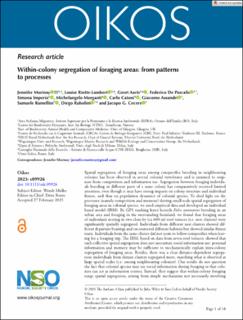| dc.description.abstract | Spatial segregation of foraging areas among conspecifics breeding in neighbouring colonies has been observed in several colonial vertebrates and is assumed to originate from competition and information use. Segregation between foraging individuals breeding in different parts of a same colony has comparatively received limited attention, even
though it may have strong impacts on colony structure and individual fitness, and thus on population dynamics of colonial species. To shed light on the processes (namely competition and memory) driving small-scale spatial segregation of foraging areas in colonial species, we used empirical data and developed an individual based model (IBM). By GPS tracking lesser kestrels Falco naumanni breeding in an urban area and foraging in the surrounding farmland, we found that foraging areas of individuals nesting in two close-by (ca 600 m) roof terraces (i.e. nest clusters) were significantly spatially segregated. Individuals from different nest clusters showed different departure bearings and encountered different habitats but showed similar fitness traits. Individuals from the same cluster did not seem to follow conspecifics when leaving for a foraging trip. The IBM, based on data from seven roof terraces, showed that such collective spatial segregation does not necessitate social information use: personal information and memory may be sufficient to mechanistically explain intra-colony segregation of foraging areas. Besides, there was a clear distance-dependent segregation: individuals from distant clusters segregated more, matching what is observed at large spatial scales (i.e. among neighbouring colonies). Our results do not question the fact that colonial species may use social information during foraging or that colonies can act as information centres. Instead, they suggest that within-colony foraging range spatial segregation, arising from simple mechanisms not necessarily involving information sharing, might be widespread in colonial systems. These results thus further challenge the long-standing view that colonies should be regarded as single cohesive entities. | en_US |

